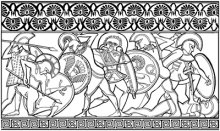
You are here
Episode 4: First Blood
Story summary
Teaching activities
- Starting points
- Follow-up
- Further activities
- Can children remember any aspects of the rich description of Troy that came at the end of the last episode?
- In the story, why did those who saw Troy feel excitement and terror?
- How does the end of Episode 3 bring us back to the beginning of the story? (We are back at Mount Olympus.)
- Ask the class to listen for the use of alliteration at the beginning of this episode, where there is a vivid picture of the Trojans’ hasty preparation for war. They can either note examples as they listen, or find some later in a
![[pdf] [pdf]](/sites/default/files/pdf_icon.png) transcript. It may be best to do either of these after they have heard the episode through once. What effect do these phrases have?
transcript. It may be best to do either of these after they have heard the episode through once. What effect do these phrases have? - Encourage thinking about the sequence of events as if they were going to re-tell the story. Again, make notes during a second hearing.
- Does the teller support the Greeks or the Trojans? Discuss third person narration and how this story would be different if it were told from another point of view.
- Go through the questions you asked at the start of this episode. Discuss the use of alliteration and ask the class to provide their own examples, from this story or elsewhere.
- Discuss the sequence of events. There are probably seven main events: the sighting of the Greek ships, preparation for war, Cygnus in battle, Achilles and Beauty, Achilles and Cygnus, Cygnus changing into a swan, the Greeks settling in for war. Prepare a simple worksheet for the class to use to help them make notes. Divide an A4 sheet into seven numbered sections so the children can write out the sequence. This will help them keep to the correct order in their own retelling of the story.
- Ask your class to imagine being a Trojan child watching the Greek ships. Children may find the picture
![[pdf] [pdf]](/sites/default/files/pdf_icon.png) On the walls of Troy (Episode 3) helpful. Alternatively imagine being a Greek warrior on board ship thinking of what to tell his family. As well as details of the actual preparations, include what their character is feeling (e.g. anger, fear, regret, pride, a mixture of all these). They might also write the battle scene from the point of view of Beauty watching her beloved master, or through Cygnus’ eyes as he clashes with Achilles.
On the walls of Troy (Episode 3) helpful. Alternatively imagine being a Greek warrior on board ship thinking of what to tell his family. As well as details of the actual preparations, include what their character is feeling (e.g. anger, fear, regret, pride, a mixture of all these). They might also write the battle scene from the point of view of Beauty watching her beloved master, or through Cygnus’ eyes as he clashes with Achilles. - The conversation between Aphrodite and Zeus can be written as a play script. The gods talk about Achilles going to his death, and how they are both, in some way, responsible. Discuss this with the class before getting them to write. Do the gods ever feel responsible for their actions?
- This episode contains powerful images. Examine the language closely. Give the class
![[pdf] [pdf]](/sites/default/files/pdf_icon.png) transcripts of sections of the story. Ask them to look for examples of figurative language, simile, repetition, how suspense is built and what effect sentence length has on storytelling.
transcripts of sections of the story. Ask them to look for examples of figurative language, simile, repetition, how suspense is built and what effect sentence length has on storytelling. - Explore the idea of oral storytelling. Ask the children whether they think this particular version of the story was written first or told first. (It was told first.)
In this episode we hear about Achilles’ relationship with his horse, Beauty. The Greeks used horses in battle and a horse was killed when Helen’s suitors swore an oath together. How did the ancient Greeks regard animals? Compare our modern use and care of animals with that of the ancient Greeks.
Visual aids
General Battle Scene
Based on a Chalcidian vase by the Inscription Painter, c. 540 BC. National Gallery of Victoria, Melbourne, Australia.
This confused scene is all limbs and weapons. In addition to the spears (which contribute so much to the composition) children will be able to pick out the plumed helmets, greaves (shin guards) and shields with prominent designs on the bosses. The shape of these shields here is more in keeping with the sixth century BC, when the vase was made, than the thirteenth century BC, when the Trojan War took place.
